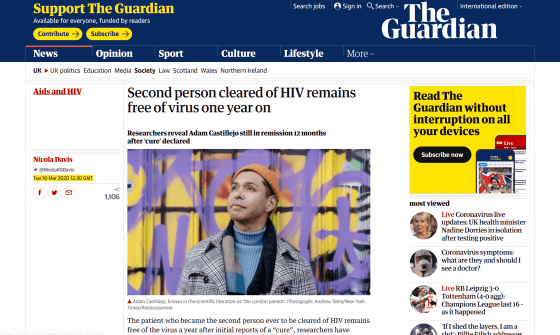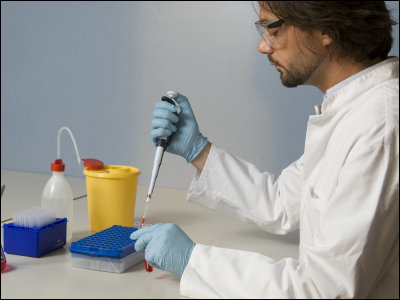A second case of AIDS who is completely cured in the world or a patient who has `` almost disappeared virus by HIV treatment '' is reported

Evidence for HIV-1 cure after CCR5Δ32 / Δ32 allogeneic haemopoietic stem-cell transplantation 30 months post analytical treatment interruption: a case report-The Lancet HIV
https://www.thelancet.com/journals/lanhiv/article/PIIS2352-3018(20)30069-2/fulltext
The 'London Patient,' Cured of HIV, Reveals His Identity-The New York Times
https://www.nytimes.com/2020/03/09/health/hiv-aids-london-patient-castillejo.html
Second person cleared of HIV remains free of virus one year on | Society | The Guardian
https://www.theguardian.com/society/2020/mar/10/second-person-to-be-cleared-of-hiv-still-free-of-virus

AIDS is known to be a very difficult disease to cure, and many patients require lifelong treatment with anti-HIV drugs. However,
Brown's surgery was called ' hematopoietic stem cell transplantation from an HIV-resistant donor.' HIV infection is closely related to a protein called CCR5 present on the surface of leukocytes, but some of it lacks a part of CCR5. 'It turns out there are people. Dr. Brown, who was diagnosed with leukemia during treatment for AIDS, was able to remove hematopoietic stem cell transplants from donors with some CCR5 deficiencies and no HIV was detected in the body.
As a result, Mr. Brown has become famous as a person whose AIDS has been completely cured, but the two surgeries he has undergone seemed to be very dangerous. It seems that there were patients who underwent similar surgery after Mr. Brown, but all died of cancer before it was confirmed that AIDS was completely cured.

However, in March 2019, the
In March 2020, one year after the second case was reported in the world where HIV was in remission, `` even if the duration of ATI is extended to 30 months, HIV is not detected in the patient's body '' New paper has been published. With the publication of this dissertation, a 'Patient in London' was first identified and interviewed.
The patient known as the 'Patient in London' is called Adam Castillejo, who is 40 by 2020. Castillejo, diagnosed with HIV in 2003, was diagnosed with leukemia in 2012 and continued chemotherapy. Meanwhile, in 2016, Castilejo received a hematopoietic stem cell transplant from an HIV-resistant donor like Brown.

by Andrew Testa / New York Times
ATI began 16 months after surgery, saying that HIV levels had been declining in Castilejo's body since he received a hematopoietic stem cell transplant. Castillejo was reported to the medical community as a 'Patient in London' in 2019 because HIV was not detected 18 months after the start of ATI. In addition, HIV has not been detected and the remission has continued, even if the duration of ATI has been extended to 30 months.
In this paper, the research team searched for HIV not only in the blood but also in cerebrospinal fluid, intestine, semen, lymph nodes, etc. to answer questions asked by other scientists after the previous paper was published However, HIV was not detected. In addition, it seems that some traces of HIV DNA were found in some cells including leukocytes, but it is said that HIV itself will not be generated from simple DNA traces. 'We're detecting a fossil virus that can't be helped,' commented research team Lavindra Gupta .
Initially announced as an anonymous person, Castilejo said of his case reported around the world, `` Even if I watch TV, I just think, 'OK, they are talking about me.' 'I was in a very strange place.' Eventually, Castilejo said he thought his case might be optimistic about the idea of AIDS patients and decided to reveal his identity. 'I want to be the ambassador of hope,' said Castillejo.
While referring to Castilejo's case, Gupta said, 'This is the second case of cure for AIDS.It has been shown that Brown's first case was neither abnormal nor accidental.' He pointed out that the treatment he received was very difficult and of great danger. He added that for most HIV-positive patients, hematopoietic stem cell transplantation from an HIV-resistant donor is not appropriate.

Related Posts:
in Science, Posted by log1h_ik







